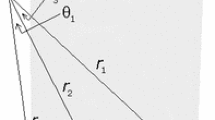Abstract
The perspective 3-point problem, also known as pose estimation, has its origins in camera calibration and is of importance in many fields: for example, computer animation, automation, image analysis and robotics. One line of activity involves formulating it mathematically in terms of finding the solution to a quartic equation. However, in general, the equation does not have a unique solution, and in some situations there are no solutions at all. Here, we present a new approach to the solution of the problem; this involves closer scrutiny of the coefficients of the polynomial, in order to understand how many solutions there will be for a given set of problem parameters. We find that, if the control points are equally spaced, there are four positive solutions to the problem at 25 % of all available spatial locations for the control-point combinations, and two positive solutions at the remaining 75 %.











Similar content being viewed by others
References
Finsterwalder, S., Scheufele, W.: Das Rückwärtseinschneiden im Raum. Sebastian Finsterwalder zum 75. Geburtstage. Verlag Herbert Wichmann, Berlin (1937)
Fischler, M.A., Bolles, R.C.: Random sample consensus: a paradigm for model fitting with applications to image analysis and automated cartography. Commun. ACM 24, 381–396 (1981)
Gao, X.S., Hou, X.R., Tang, J., Cheng, H.F.: Complete solution classification for the perspective-threepoint problem. IEEE Trans. Pattern Anal. Mach. Intell. 25, 930–943 (2003)
Grafarend, E.W., Lohse, P., Schaffrin, B.: Dreidimensionaler rückwärtsschnitt, Teil I: Die projektiven Gleichungen, pp. 1–37. Zeitschrift für Vermessungswesen, Geodätisches Institut, Universität, Stuttgart (1989)
Grunert, J.A.: Das Pothenotische Problem in erweiterter Gestalt nebst über seine Anwendungen in der Geodäsie. Grunerts Archiv für Mathematik und Physik 1, 238–248 (1841)
Haralick, R.M., Lee, C., Ottenberg, K., Nolle, M.: Review and analysis of solutions of the 3-point perspective pose estimation problem. Int. J. Comput. Vis. 13, 331–356 (1994)
Lazard, D.: Quantifier elimination: optimal solution for two classical examples. J. Symb. Comput. 5, 261–266 (1988)
Linnainmaa, S., Harwood, D., Davis, L.S.: Pose determination of a three-dimensional object using triangle pairs. IEEE Trans. Pattern Anal. Mach. Intell. 10, 634–647 (1988)
Merritt, E.L.: Explicit three-point resection in space. Photogr. Eng. XV, 649–655 (1949)
Quan, L., Lan, Z.: Linear N-point camera pose determination. IEEE Trans. Pattern Anal. Mach. Intell. 21, 774–780 (1999)
Rees, E.L.: Graphical discussion of the roots of a quartic equation. Am. Math. Mon. 29, 51–55 (1922)
Rieck, M.Q.: Handling repeated solutions to the perspective three-point pose problem. In: Richard, P., Braz, J. (eds.) VISAPP (1), pp. 395–399. INSTICC Press, Madeira (2010)
Rieck, M.Q.: An algorithm for finding repeated solutions to the general perspective three-point pose problem. J. Math. Imaging Vis. 42, 92–100 (2012)
Rieck, M.Q.: A fundamentally new view of the perspective three-point pose problem. J. Math. Imaging Vis. 48, 499–516 (2014)
Su, C., Xu, Y., Li, H., Liu, S.: Application of Wu’s method in computer animation. Proc. Fifth Int. Conf. CAD/CG 1, 211–215 (1997)
Su, C., Xu, Y., Li, H., Liu, S.: Necessary and sufficient condition of positive root mumber of P3P problem. Chin. J. Comput. Sci. 21, 1084–1095 (1998)
Wolfe, W.J., Mathis, D., Sklair, C.W., Magee, M.: The perspective view of three points. IEEE Trans. Pattern Anal. Mach. Intell. 13, 66–73 (1991)
Yang, L.: A simplified algorithm for solution classification of the perspective-three-point problem. Tech. rep, MM-Preprints, MMRC, Academia Sinica (1998)
Yuan, J.S.C.: A general photogrammetric method for determining object position and orientation. IEEE Trans. Robot. Autom. 5, 129–142 (1989)
Zhang, C.X., Hu, Z.Y.: A general sufficient condition of four positive solutions of the P3P problem. J. Comput. Sci. Technol. 20, 836–843 (2005)
Zhang, C.X., Hu, Z.Y.: Why is the danger cylinder dangerous in the P3P problem? Acta Autom. Sin. 32, 504–511 (2006)
Zhang, C.X., Hu, Z.Y.: A probabilistic study on the multiple solutions of the P3P problem. J. Softw. 18, 2100–2104 (2007)
Acknowledgments
M. Vynnycky acknowledges the support of the Mathematics Applications Consortium for Science and Industry www.macsi.ul.ie, funded by the Science Foundation Ireland (SFI) Mathematics Initiative Grant 06/MI/005 and SFI Grant 12/IA/1683, as well as funding support from Research Institute of Electronics, Shizuoka University, Japan, for visiting and cooperative research. The authors also acknowledge useful discussions with Prof. J. A. Cuminato, and the comments of an anonymous referee.
Author information
Authors and Affiliations
Corresponding author
Appendix: \(\varDelta _{W},P,D,q\)
Appendix: \(\varDelta _{W},P,D,q\)
Substituting (43)–(47) into (49) gives, on factorizing,
where
and
as also obtained previously by Rieck [13]. Observe that \(f_{1}\left( 0,0,0\right) =-1,\) which means that \(\varDelta _{W}>0\) within the double crown-like shape shown in Fig. 8, and \(\varDelta _{W}<0\) between it and the inflated tetrahedron. Note also that \(f_1=0\) corresponds to what is commonly referred to as the danger cylinder [20, 21], as noted by [12].
Similarly, substituting (43)–(47) into (50) gives
where
whereas (52) leads to
where
Also,
where
Rights and permissions
About this article
Cite this article
Vynnycky, M., Kanev, K. Mathematical Analysis of the Multisolution Phenomenon in the P3P Problem. J Math Imaging Vis 51, 326–337 (2015). https://doi.org/10.1007/s10851-014-0525-0
Received:
Accepted:
Published:
Issue Date:
DOI: https://doi.org/10.1007/s10851-014-0525-0




